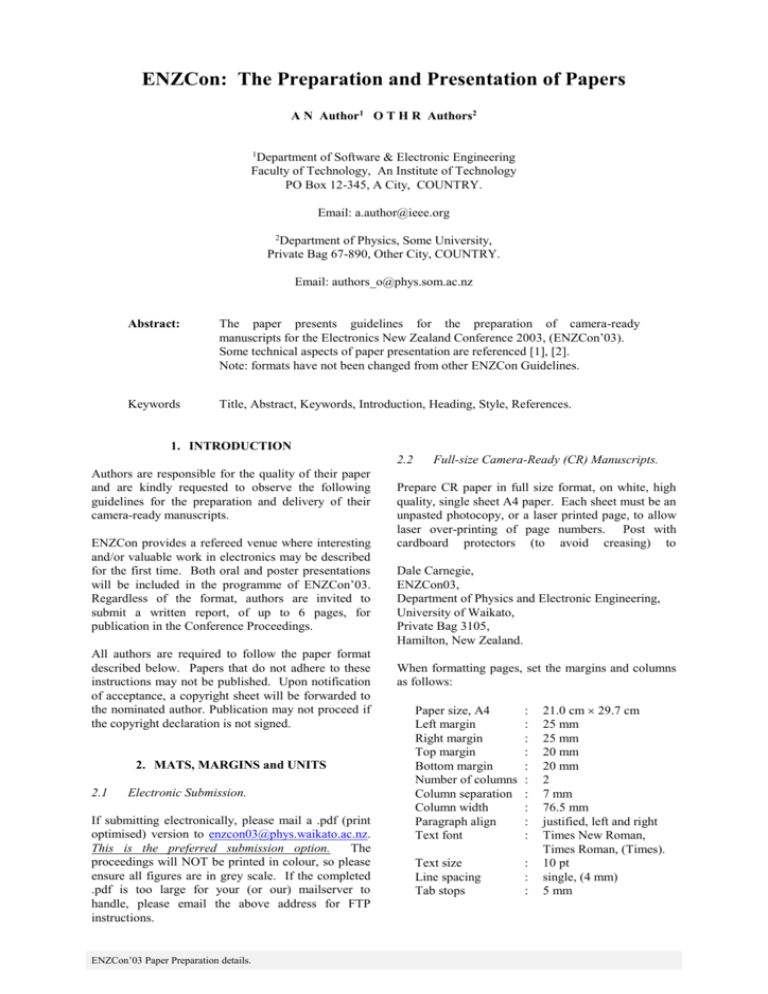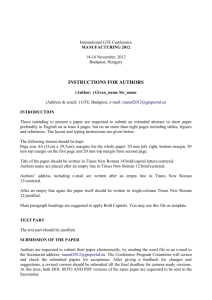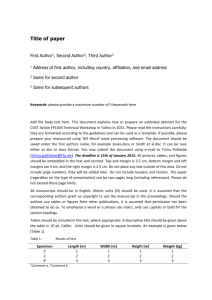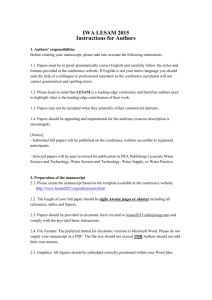INTELLIGENT ERASING OF THE EPROM IN MICROCONTROLLERS:
advertisement

ENZCon: The Preparation and Presentation of Papers A N Author1 O T H R Authors2 1 Department of Software & Electronic Engineering Faculty of Technology, An Institute of Technology PO Box 12-345, A City, COUNTRY. Email: a.author@ieee.org 2 Department of Physics, Some University, Private Bag 67-890, Other City, COUNTRY. Email: authors_o@phys.som.ac.nz Abstract: The paper presents guidelines for the preparation of camera-ready manuscripts for the Electronics New Zealand Conference 2003, (ENZCon’03). Some technical aspects of paper presentation are referenced [1], [2]. Note: formats have not been changed from other ENZCon Guidelines. Keywords Title, Abstract, Keywords, Introduction, Heading, Style, References. 1. INTRODUCTION 2.2 Authors are responsible for the quality of their paper and are kindly requested to observe the following guidelines for the preparation and delivery of their camera-ready manuscripts. ENZCon provides a refereed venue where interesting and/or valuable work in electronics may be described for the first time. Both oral and poster presentations will be included in the programme of ENZCon’03. Regardless of the format, authors are invited to submit a written report, of up to 6 pages, for publication in the Conference Proceedings. All authors are required to follow the paper format described below. Papers that do not adhere to these instructions may not be published. Upon notification of acceptance, a copyright sheet will be forwarded to the nominated author. Publication may not proceed if the copyright declaration is not signed. 2. MATS, MARGINS and UNITS 2.1 Electronic Submission. If submitting electronically, please mail a .pdf (print optimised) version to enzcon03@phys.waikato.ac.nz. This is the preferred submission option. The proceedings will NOT be printed in colour, so please ensure all figures are in grey scale. If the completed .pdf is too large for your (or our) mailserver to handle, please email the above address for FTP instructions. ENZCon’03 Paper Preparation details. Full-size Camera-Ready (CR) Manuscripts. Prepare CR paper in full size format, on white, high quality, single sheet A4 paper. Each sheet must be an unpasted photocopy, or a laser printed page, to allow laser over-printing of page numbers. Post with cardboard protectors (to avoid creasing) to Dale Carnegie, ENZCon03, Department of Physics and Electronic Engineering, University of Waikato, Private Bag 3105, Hamilton, New Zealand. When formatting pages, set the margins and columns as follows: Paper size, A4 Left margin Right margin Top margin Bottom margin Number of columns Column separation Column width Paragraph align Text font : : : : : : : : : : Text size Line spacing Tab stops : : : 21.0 cm 29.7 cm 25 mm 25 mm 20 mm 20 mm 2 7 mm 76.5 mm justified, left and right Times New Roman, Times Roman, (Times). 10 pt single, (4 mm) 5 mm Footnotes should not extend into the bottom 20 mm margin space. This is reserved for page numbering. 2.2 Units SI units must be used for primary units. If necessary, CGS or other units may be used, but avoid combining SI and other units (e.g., current in Amperes and magnetic field in Oersteds!). Never use English units, unless they are identifiers in trade (e.g., “3.5-inch disk drive”) 3. HEADINGS 3.1 Main Headings The main heading should be typed in capitals, numbered and centred. Leave a space of two lines above and one line below the main headings. 3.2 4.3 Paper text The main text of the paper should be in 10 pt Times. A blank line separates paragraphs from each other, and all text is justified left and right. Paragraphs (except for references) are not indented. 4.4 Figures and Tables Figures and tables should be placed in the paper body, as close to where they are referenced as possible. If this cannot be done, then they may be placed in the appendix and clearly referenced. Figures and tables should be clearly and simply captioned, although sufficient information should be provided for the figure to be understood without further reference to the text. If necessary, figures and tables may extend across the full page, between the 25 mm margins, at either the top or bottom of the page. Subheadings Subheadings should be typed flush to the left hand side of the column in lower case with initial capitals for all main words. Underline or italicise these headings and leave a space of 1 line above and below. Figure numbers and captions should be typed below the figures. 3.2.1 Subsubheadings. These should be typed as for 3.2 Subheadings and be underlined or italicised. The text following should continue after a full stop. The use of more than three levels of headings is discouraged. 4. STYLE 4.1 First Page The Title block is centred. The title font and size are 16 pt Times New Roman, bold, and the first letter of each main word should be capitalised. Author names should be 10 pt bold, one (14 pt) line below the title, and centred. Following the author name(s) is a two-line space and then the author affiliations, addresses and email addresses, which are also centred and each (if more than one) separated by one line. The abstract and keywords follow, as shown on the first page. This text is 10 pt and paragraphs are indented, left and right, by 10 mm. The abstract is recommended to be within 50 to 100 words. Three to seven keywords should be presented to indicate the main topics discussed in the paper. 4.2 Units There should be a space between a value and the corresponding unit, for example, 10 mm. ENZCon’03 Paper Preparation details. Figure 1. Front Operating Panel of the ROV Table captions, however, should be defined before the table item. TABLE 1. (1) (2) (3) 4.5 The caption comes before the table. X 10.2 31.1 0.52 Y 11.6 33.9 0.25 Z 15.3 29.8 0.12 Equations Equations should be typed within the text and should be numbered consecutively throughout the typescript. The equation number should be typed in parenthesis, flush with the right-hand margin of the column AB AB (1) B. Provo, “NELCON Conferences: The Presentation and Preparation of Papers.” NELCON’92 guideline to authors. 5. CONCLUSIONS Once a manuscript has been sent to the printers, corrections or changes to it cannot be made. Therefore, please check camera-ready manuscripts thoroughly before submission. Finally, a checklist: Check that the paper is in the correct ENZCon format, and no more than 6 pages in length? Keep a photocopy of the manuscript. Please put name(s), paper title and page number on the back of each sheet in pencil. Please provide an (email) address for receipt acknowledgment of your paper. 6. APPENDIX Appendices should be used to present information that is not directly relevant to the theme of the paper. Full page figures, diagrams, or tables may also be placed here. Sources of information that do not meet strict reference criteria should also be placed in an appendix. These may include FTP and WWW site addresses, as well as details of technical data that may be useful to those wishing to pursue details of your paper. 7. ACKNOWLEDGMENTS The acknowledgment section should acknowledge those sources and individuals whose support, information and/or work has contributed to the content, or assisted the development, of the paper. Such contribution or assistance should be significant, but would not warrant inclusion as an author, nor meet reference criteria. This paper has been very slightly modified from the version prepared for previous ENZCon conferences. The following was found useful in the preparation of this example paper: 8. REFERENCES These are an important part of any technical or research publication. Sufficient information must be provided to make it easy for readers to check the validity of any quotes or referenced material that the author has noted in support of the paper's content. Material that is referenced should have been published in a form that is readily accessible. Currently, this means that quoted references should be archived at sites accessible through standard library services (for example: printed journals and proceedings). 8.1 Reference format References must be typed in a separate reference section at the end of the paper, with items referred to by numerals in square brackets. The order of references should match the order in which the material is cited in the body of the paper. References should be completed in IEEE style as follows: Papers: Author(s) first initials followed by last name, title in quotation marks, periodical in italics, volume, inclusive page numbers, month and year. Books: Author(s) first initials followed by last name, title in italics, location, publisher, year, chapter, inclusive page numbers (where appropriate). Format the reference paragraphs with a 0.7 mm tab stop and a 7 mm hanging indent. The tab stop should follow the reference number, before the author(s) name. [1] G. Moss, Visual Ways, MAF Advisory Aid Book, B. Marris Ed., Government Printer, Wellington, 1982. “IEEE Information for Authors”, IEEE Transactions on Robotics and Automation, 1995. [2] G. Moss and J. Magurk, (Editors), Ways With Words, MAF Advisory Aid, Government Printer, Wellington, 1976. “Preparation of Papers in Two-Column Format for M2VIP’95” guidelines to authors, Mechatronics and Machine Vision in Practice, Hong Kong, 1995. [3] Electronic Design, How To Write for Electronic Design, Hayden/VNU, Hasbrouck Heights, NJ 07604, received 1988. D.A. Carnegie, “ENZCon Conferences: The Preparation and Presentation of Papers.”, ENZCon 1994 and 1995 guidelines to authors. [4] J. Fraser, (Ass. Editor) “At the Next Technical Conference, Don't Just Sit There,” EDN, Relevant Issues editorial, pp 2-23, May 2 1991. ENZCon’03 Paper Preparation details.





